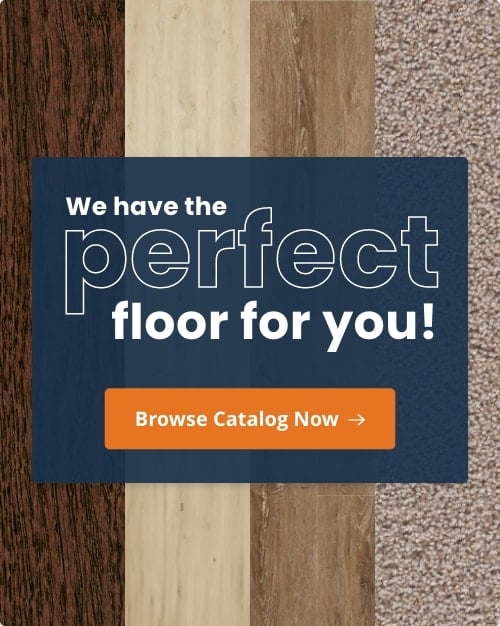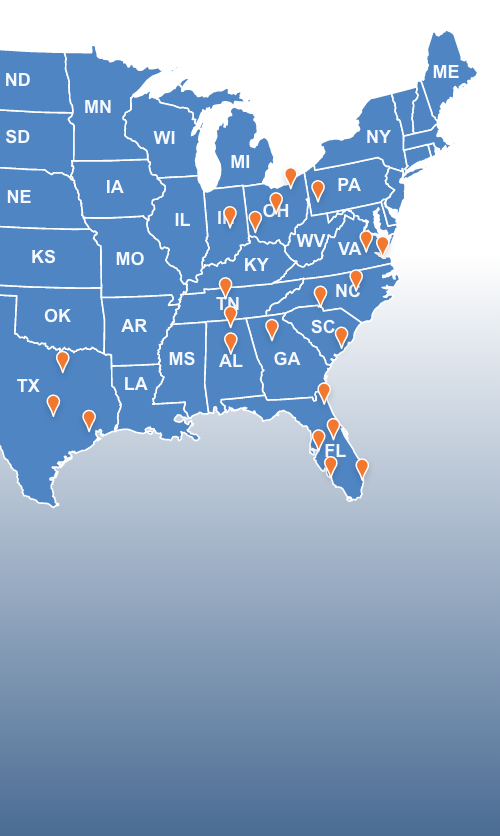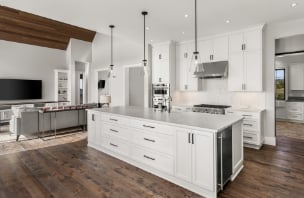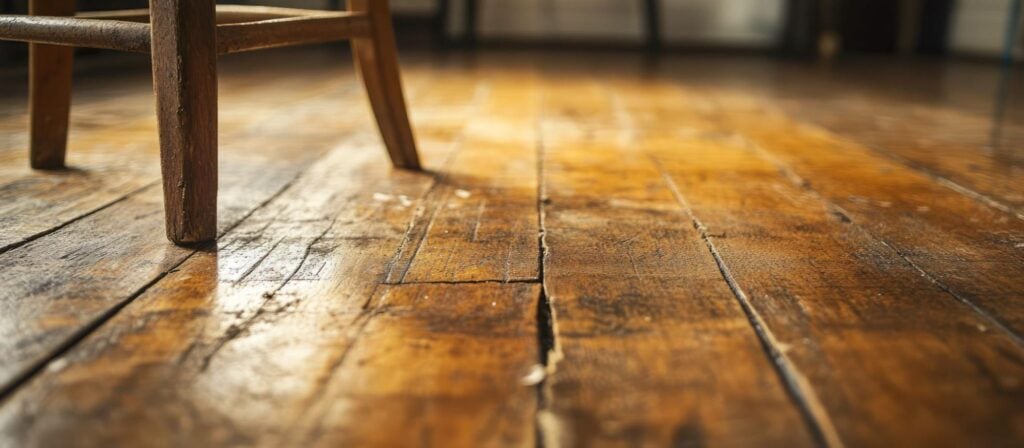

Beautiful hardwood floors can last for generations when properly cared for. In fact, it’s not uncommon to find historic properties with original flooring. Hardiness is one of the reasons why hardwood flooring is so popular.
Although quality floors can last for a long time, hardwood floor damage can occur, and it can happen with common issues, including:
Moisture Related Damage
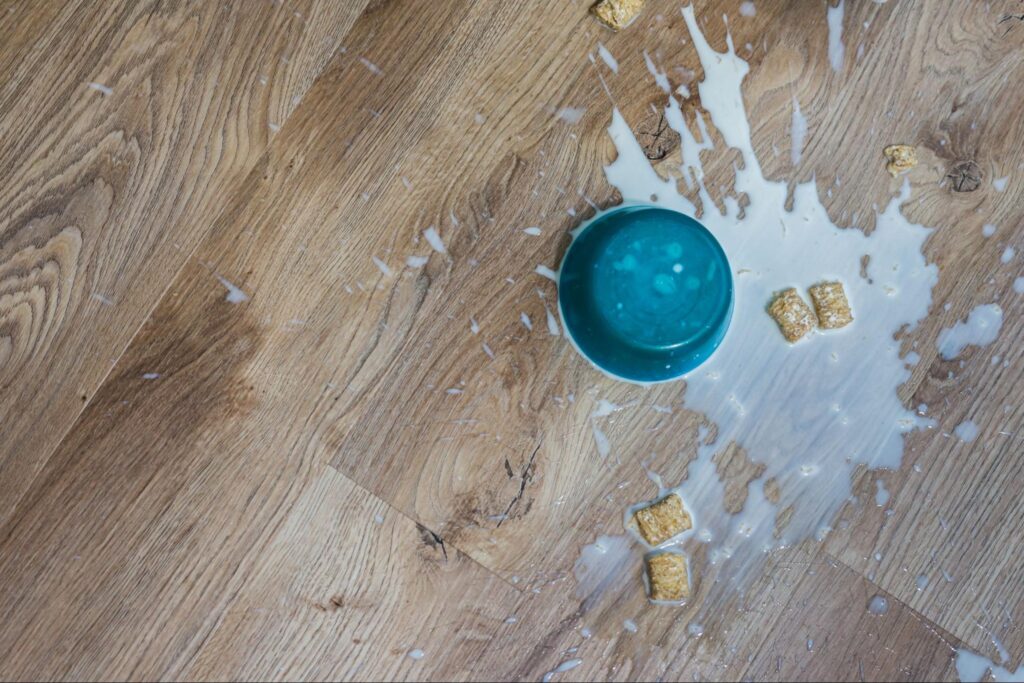
1. Liquid
Liquid can get into the seams of hardwood flooring, leading to too much moisture and subsequent moisture damage. Over time, this moisture can weaken the wood, causing it to warp or swell.
If left untreated, prolonged exposure to moisture can create the ideal conditions for mold growth, which can affect both the floor and the air quality in your home.
A moisture meter helps detect hidden moisture in the wood, even if it’s not visible on the surface. It works by measuring the amount of water present inside the wood, which can help you prevent further damage.
By checking the moisture levels regularly, homeowners can catch problems early, before they cause significant warping or mold growth. This tool is essential for maintaining the integrity of hardwood floors and ensuring their longevity.
2. Buckling
Buckling is one of the common wood floor problems that occurs when floorboards lift away from the subfloor, often due to water damage from flooding or leaks.
When water sits on the floor for too long, it weakens the wood and adhesives, causing the boards to warp. Lack of expansion joints can also contribute, as these joints help the wood expand and contract with changes in moisture.
How to Fix Buckling:
- Find the Source of Moisture: Identify and fix the cause of the water damage, such as a leak or flooding, to stop further issues.
- Remove Damaged Boards: Carefully take up the affected boards without damaging surrounding ones.
- Dry the Area: Use fans and dehumidifiers to fully dry the area, including the subfloor, to prevent mold.
- Check Moisture Levels: Use a moisture meter to ensure everything is dry. The wood should be around 6-9% moisture content before reinstalling.
- Replace or Repair Boards: If the damage is severe, install new boards. If not, reposition the dried boards.
- Install Expansion Joints: If lack of expansion joints caused the buckling, make sure to add them to prevent future problems.
Following these steps will fix existing buckling and help prevent it from happening again.
Physical Damage
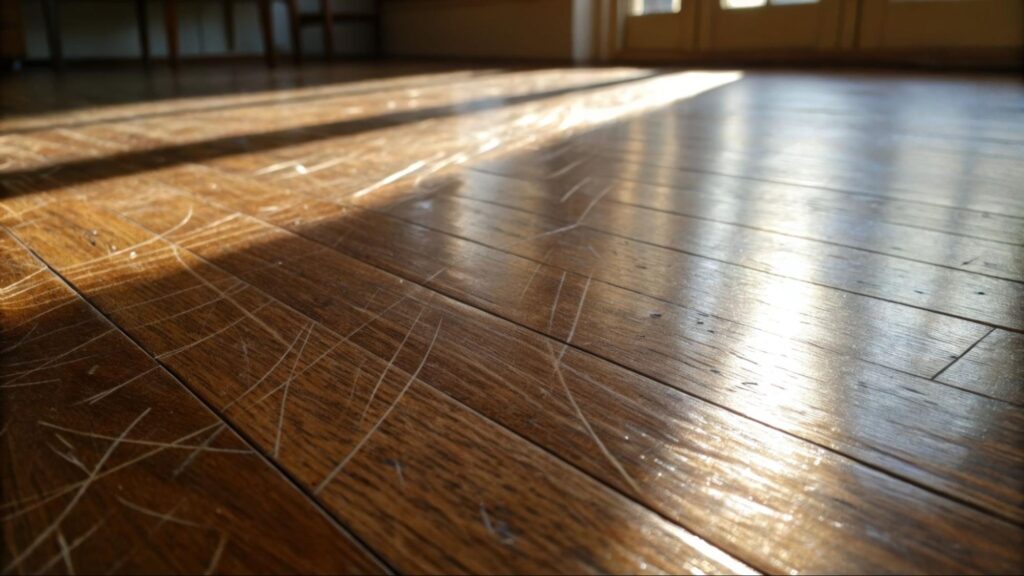

3. High heels
High heels on wood floors can scuff or even scratch the surface. Going shoe-free or wearing slippers indoors can help you keep your floors beautiful. Not wearing outdoor shoes inside can also help you avoid tracking dirt and germs into your home.
Applying a scratch-resistant finish to your wood floors can provide an additional layer of protection. This wood floor finish helps to minimize the impact of minor scratches and keeps your floors looking pristine. Regular cleaning and maintenance are also crucial.
4. Pet nails
Pet’s nails can scratch hardwood flooring, making them look dull or damaged with time. Trimming your pet’s nails before you hear that tell-tale “click click click” on the floors is comfortable and healthy for your pet and helps you keep your home looking its best.
Pet urine can also cause significant damage to wood floors, leading to issues like finish deterioration and warping, so it is important to clean it promptly.
7. Debris
Tiny debris, such as pieces of gravel, can be ground into the surface of your floor and can even become embedded in the surface.
Dust and debris can act like sandpaper, gradually wearing down the finish and leading to more significant damage. By keeping your floors clean and well-maintained, you can extend their lifespan and keep them looking their best.
5. Furniture
Every time you sit down on furniture, the legs of your chairs, sofas and other pieces can dig into the wood, leaving scratches and even gouges.
Place furniture pads under all your furniture and on all furniture legs. Check the furniture pads regularly to make sure they are still on correctly and have not fallen off. You may need to replace them as they wear down so they provide enough cushion.
6. Moving
While dropping a heavy item on hardwood floors can cause homeowners to gasp, moving heavy furniture can be just as high-risk a situation for your floor’s appearance.
Always lift furniture completely off the floor and set it down gently. Work with professional movers where possible and use thick moving blankets under any furniture that’s too heavy to lift and must be dragged across the floor.
Environmental Damage
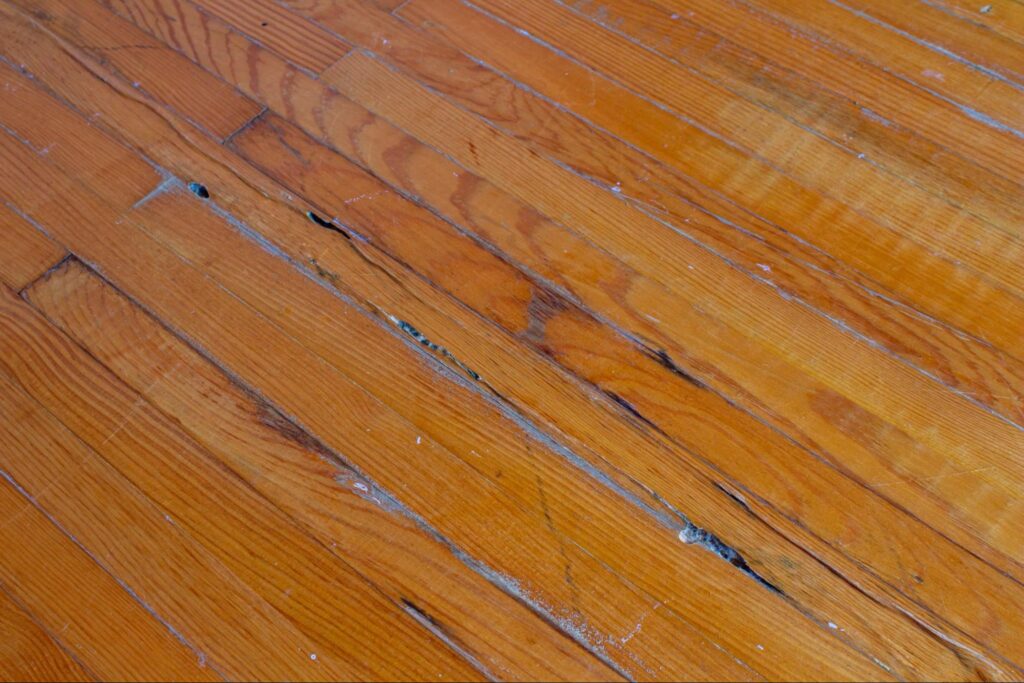

8. Crowning
Crowning refers to a specific type of distortion in hardwood flooring. It occurs when the top surface of the board becomes more humid than its underside. This imbalance results in the center of the board expanding and arching upwards.
How to Address Crowning
- Identify the Root Cause:
- Before tackling the cosmetic aspect, it’s crucial to diagnose the source of the moisture imbalance. Check for environmental factors or moisture infiltration.
- Climate Control Solutions:
- If the distortion is due to environmental moisture, using a dehumidifier can help regulate the relative humidity levels.
- Restoration Process:
- Once the flooring has returned to a stable moisture level, you can sand down the raised center of the boards. Follow this by refinishing your hardwood for a smooth, even appearance.
Make sure that the underlying moisture issues are resolved permanently to prevent future crowning.
9. Gaps
Gaps between floorboards are a common issue in wood floors, mainly due to natural changes in moisture levels and temperature throughout the year.
Why Do Gaps Form?
- Seasonal Changes: Wood naturally expands and contracts with changes in humidity. If your wood floor was installed during a humid period, like summer, it might shrink during the drier, colder months of winter, leading to visible gaps.
- Moisture Levels: Variations in indoor humidity contribute to the expansion and contraction of wood. Wood loses moisture in a dry environment, causing it to contract.
- Installation and Age: Older floors or improperly installed floorboards may also exhibit gaps as they settle over time.
10. Sun Exposure
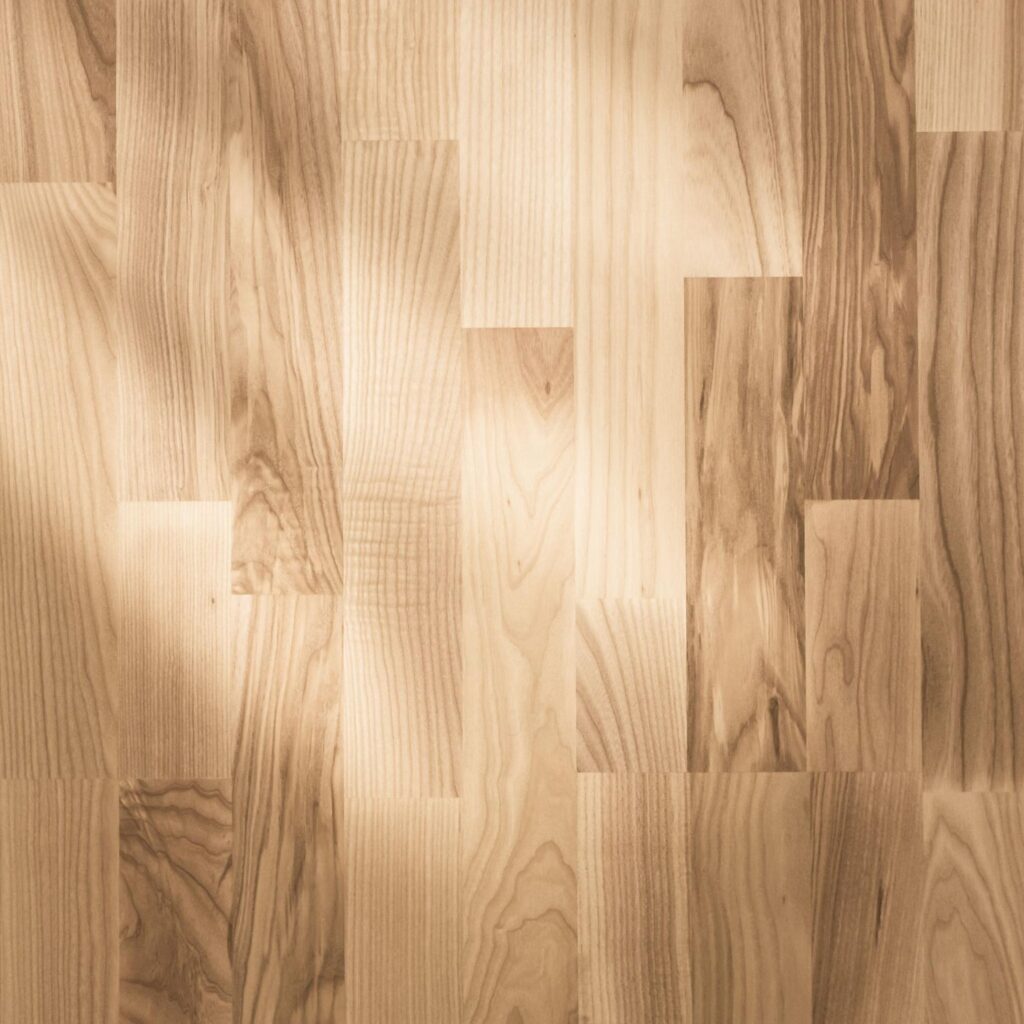

Direct sunlight on your floors can cause fading and discoloration. It will also create an uneven look since areas near your windows will be most affected. Always close your drapes or use sheer curtains to protect your home.
11. Temperature Extremes
Temperature extremes can damage wood floors by causing them to expand and contract, leading to cracks and gaps.
Wood naturally reacts to changes in temperature and humidity. When exposed to extreme conditions, it can swell or shrink, affecting the floor’s integrity.
To protect your floors, maintain a consistent indoor temperature between 60-80°F (15-27°C). Sudden temperature changes can cause the wood to shift too quickly.
Using a humidifier or dehumidifier helps keep humidity levels stable. The National Wood Flooring Association (NWFA) recommends keeping indoor humidity between 30-50%.
Also, regularly check the moisture content of your floors with a moisture meter to ensure it stays within the right range. These steps will help prevent damage from temperature extremes and keep your wood floors in good condition.
How To Protect Wood Floors
Knowing how to protect your floors lets you make the most out of your investment. Here are a few tips for protecting and caring for your hardwood flooring:
Properly Install Your Hardwood Floors
Proper installation of a hardwood floor is the first step in preventing moisture issues. Ensure the flooring is installed in a controlled climate, ideally with a functioning HVAC system.
Use a moisture meter to confirm the wood’s moisture content before installation—aim for it to be within 2–4% of the subfloor’s moisture content.
If necessary, follow the acclimation process to adjust the wood’s moisture level. A moisture barrier over the subfloor can also help, so check with the manufacturer for the right type. Use appropriate fasteners to secure the flooring.
Clean Your Floors Properly
Sweep floors regularly and do not use large amounts of liquid. Use damp mops and dry, soft brooms instead.
If you notice a spill or any debris, clean it up at once. Never use cleaners with acrylics or urethane. Read the label and make sure you’re using a cleaner intended for hardwood floors. When using a new cleaner for the first time, use it on a tiny and inconspicuous part of the floor first.
Maintain Your Hardwood Floors
Familiarize yourself with the manufacturer guidelines that came with your hardwood flooring, and maintain your floors as directed.
Prevent or Fix Gaps
- Monitor Humidity: One effective solution is to maintain consistent humidity levels in your home. Use a humidifier during the winter to add moisture to the air, which can help wood retain its shape.
- Correct Timing for Filler: If the gaps are not due to seasonal changes, applying wood filler might be a viable fix. Ensure you do this in the summer when gaps are at their narrowest to avoid further issues during expansion.
- Consider Replacement: For large or unsightly gaps, particularly in older floors, replacing the floorboards could be the best option. Large gaps might not respond well to wood filler, which doesn’t fully replicate the appearance of wood.
Depending on your lifestyle, occasionally refinishing the entire floor might become necessary to restore their appearance.
Consider additional protection
In high-traffic areas, especially, use a mat or area rug to protect your floors. However, avoid rubber backings and rubber no-slip treads. A combination felt and rubber pad is much gentler on floors.
One additional tip — choosing quality hardwood floors designed for your lifestyle is a good way to ensure your floors stay looking their best.
Take Action to Protect Your Hardwood Floors from Common Damage
To keep your hardwood floors looking great and lasting for years, it’s important to address common causes of damage, like moisture, heavy foot traffic, and improper cleaning methods. Regular maintenance, timely repairs, and using the right cleaning products can go a long way in preserving the beauty of your floors.
Of course, all floors eventually reach the end of their life and need to be replaced. For other homeowners, it’s just time for a style refresh. If you’re considering replacing your floors, contact 50Floor today. Our flooring experts will bring samples to your home and help you choose the right style for your needs and budget.

